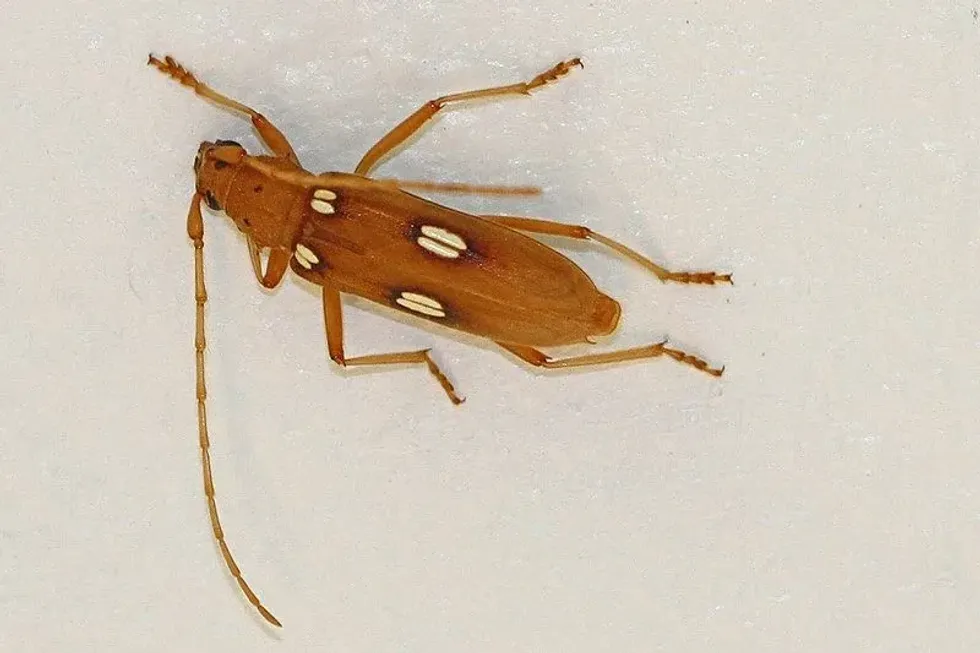Ivory-marked beetle (Eburia quadrigeminata), also known as an ivory-marked borer, is a beetle of the family Cerambycidae. This beetle belongs to the Eburia genus, Eburiini tribe, and Cerambycinae subfamily.
The tribe Eburiini is synonymous with the Heteropsini Lacordaire tribe, 1868. The subfamily consists mostly of longhorn beetles.
Cerambycinae has 3,900 species within 712 genera, and these beetles widely occupy the Americas. Longhorn beetles or Cerambycidae family is a large beetle family with more than 35,000 recognized species. The ivory-marked beetle has a range from brown to golden brown color with ivory or white spots on the wings.
The scientific name of this family of beetle is a derivation of a Greek mythological figure; a shepherd, Cerambus, was turned into a large beetle with horns after an argument with nymphs. This family consists of eight subfamilies.
The larvae are called roundheaded borers as they bore into woods damaging weak trees. They live up to 10-40 years.
If these facts about the ivory-marked beetle species are interesting, then you may also check out these facts about the eastern eyed click beetle and fungus beetle.
Ivory-Marked Beetle Interesting Facts
What type of animal is an ivory-marked beetle?
Eburia quadrigeminata is a species of beetle in the order Coleoptera and phylum Arthropoda. They belong to the longhorned beetle family. This beetle is a native species of North America. This beetle is active in the summer and has habits of boring in trees.
What class of animal does an ivory-marked beetle belong to?
Eburia quadrigeminata belongs to the class insects of animals.
How many ivory-marked beetles are there in the world?
The exact number of the ivory-marked beetle in the world is not known. There are around 250,000-350,000 species of beetle with varying length, weight, and color.
Where does an ivory-marked beetle live?
Ivory-marked beetle location of habitat has a moderately broad range in the Central and Eastern United States, which includes parts of Arizona and Mexico. ivory-marked borer's natural population has never been found in Africa. These insects were introduced in Argentina and Cuba.
What is an ivory-marked beetle's habitat?
The ivory-marked longhorn beetle's preferred habitat is Deciduous forests ad woodlands. Larvae infestation occurs in heartwood as they bore into the tree including hickory, locust, oak, elm, maple, ash, lumber, cherry, chestnut, and beech. They can also occur in homes with woods and wooded regions.
Who do ivory-marked beetles live with?
The ivory-marked beetle lives in groups.
How long does an ivory-marked beetle live?
The duration of the ivory-marked beetle life cycle takes two years to complete. This heartwood boring species has the longest life cycle among other longhorned wood-boring beetles. The adult can live up to 10-15 years.
How do they reproduce?
During mating, the antennae of the male come in contact with females. The long antennae are more efficient for searching for a mate than a shorter one. The male will recognize a female as a potential mate after the female releases chemicals from her exoskeleton.
Females lay one egg. She lays her eggs in cracks or fissures in the bark of a dead tree. These ivory-marked beetle eggs are laid in spring.
As the larvae grow slowly due to a lack of nutrients in dead trees, the larvae development takes up to two years. The larvae after hatching bores into the central heartwood. These adult species were found emerging from sills, flooring, and other wood specimens.
What is their conservation status?
The conservation status of the ivory-marked longhorn beetle is Not Evaluated.
Ivory-Marked Beetle Fun Facts
What do ivory-marked beetles look like?
Adults species of ivory-marked borer are small to average sized species. ivory-marked beetle identification feature includes four white spots on their elytra or wing covers on their light brown-colored body. Each pair of these white spots are covered by a dark brown halo. There is a small spine on each side of the thorax.
As they are longhorned species their antennae are longer in length than their body. They have a round pronotum, which is wide in the middle. They have a forward-slanted face that looks nearly vertical.
How cute are they?
The ivory-marked borer beetle has distinct spots which distinguish them from other borer beetles. However, they are no considered cute.
How do they communicate?
These beetle adults communicate using chemicals, contact, and antennae. Also, the ivory-marked beetle sound is a chirping noise.
How big is an ivory-marked beetle?
Adults measure up to 0.47-0.98 in (12-25 mm) in length. These insects are twice the size of a soldier beetle.
How fast can ivory-marked beetles move?
The exact speed of this insect species is not known.
How much does an ivory-marked beetle weigh?
The weight of these North American species is not yet known.
What are the male and female names of the species?
There is no specific name given to male and female ivory-marked beetle.
What would you call a baby ivory-marked beetle?
There is no specific name given to the baby ivory-marked beetle.
What do they eat?
These North American beetles feed on decaying or dead trees. They feed on twigs, wood pulps, and leaves. These beetles can also infest decaying cypress trees too.
Are they harmful?
No, these North American species are not harmful to humans. The ivory-marked beetle damage does not destroy infested trees. In some areas, these beetles species cause a lot of damage to timber. Also, they can also be a hard pest to get rid of in the lumber industry.
Would they make a good pet?
No, they would not make a good pet. They thrive in nature around the oak, elm, maple, hickory, lumber, and ash trees.
Did you know...
These beetles like all the other beetle are attracted to lights.
The larvae are hardy as they live a tough life. They can survive millings, cutting, and finishing, emerging out of the finished products years later.
Some predators of these beetles in nature are wasps, flies, bats, and lizards.
These beetles are able to travel to places within the furniture. It was reported in Egypt in Cairo that ivory-marked beetle emerged out of a cabinet that was imported from France.
The subfamily Cerambycinae species occurs across the world, particularly in the neotropical areas.
Another subfamily with comparable diversities is Lamiinae in this family Cerambycidae.
Several longhorn beetles can mimic wasps, ants, and bees.
Do ivory-marked beetles bite?
No, ivory-marked beetles do not bite.
How to get rid of ivory-marked beetles?
These pests are attracted to warm shelters, easy accessibility, food, and water. If there is an infestation make sure to identify the beetles.
You use few natural home remedies like neem oil, peppermint oil, Pyrethrin, Diatomaceous earth (DE), lavender, and insect traps. All these natural methods have their own advantages and disadvantages. All the oils and sprays need re-application.
You can also use bait stations to attract and kill these insects. It is not only important to control the population growth but it becomes essential to prevent access to these species.
Placing fresh caulk around doors, vent seals, and windows to prevent the entry of these beetles. You can also hire professionals for the management of pests.
The professionals first will inspect the property for any beetle infestation. They will provide industry-based information about what is causing the infestation and this will help you prevent re-infestation.
In the final step, they provide you with planning and follow-ups. Few other methods are vacuuming, soap spray, using insecticides, and hang beetle traps. As they do not infest on living and healthy trees they occur less in a lot of landscapes.
You can also prevent these beetles from entering your house by sealing entry points properly and taking care of cracks around your house. Try to remove all the food sources that might attract beetles.
Here at Kidadl, we have carefully created lots of interesting family-friendly animal facts for everyone to discover! For more relatable content, check out these click beetle facts and stag beetle facts pages.
You can even occupy yourself at home by coloring on one of our free printable Ivory-Marked Beetle coloring pages.










